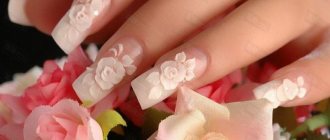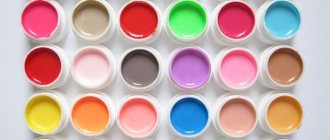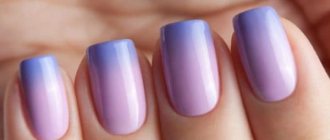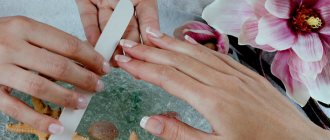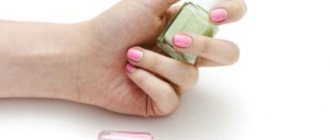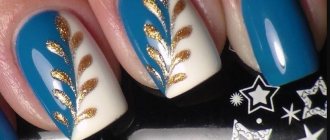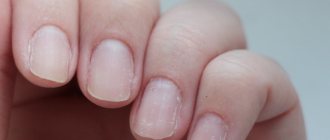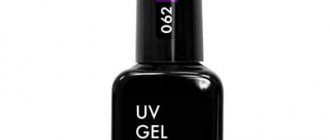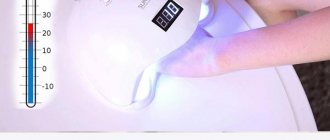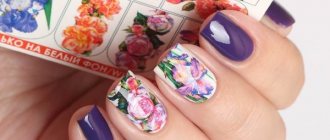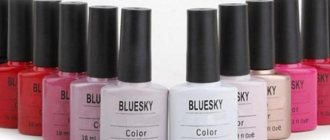Is gel polish harmful?
To wear gel polish without harming your nails, you must first make sure that it does not contain formaldehyde, toluene, or dibutyl phthalate. You don't have to worry about the rest.
By the way, gel polishes usually contain:
- coloring pigments responsible for the color and saturation of the coating;
- photoinitiator is a component that absorbs the radiation of a UV lamp and protects the nail plate when drying gel polish. Non-toxic and harmless;
- The film former is a very ultraviolet-sensitive substance. Creates a stable film on the surface of the nails;
- Thinners are minor components; they can be chemical or natural. They are responsible for the consistency of the varnish; the adhesion of the coating to the nail plate depends on them;
- various fillers – provide viscosity, shine, etc. (for example, glitter) .
Gel polish. Myths and reality (part two)
Hello girls! While the baby is sleeping and I have some free time, I’ll probably continue
picture to attract attention
Part three - wellness
I quite often come across the statement “gel polish ruins your nails” and every time I feel very sad, because this coating helped me restore my nails after two years of vigorous indulgence. That’s why now I want to take this myth (yes, it’s a myth, I think!) to pieces.
So what actually spoils nails (after all, this is not fiction, nails really spoil)?
* The human factor is the master.
(I’ll make a reservation right away that, of course, there are different masters, there are also very good, super responsible and wonderful ones who care about the health of the client’s nails, but below we are not talking about them)
What does a master need?
- large color palette. Therefore, it is much easier and cheaper to buy Chinese noname on sale for 5 rubles per bunch, and provide yourself with a varied palette that you are not ashamed to show to the client, than to use expensive materials. *yes, kayatai can be good and of high quality, but... for the most part it’s still a lottery, I don’t know about you, but I’m not ready to participate in it with my nails* especially the smart ones even stick stickers on the bottles with the proud inscription “shellac”, honestly, honestly , I saw it myself!
- speed. This point especially applies to “green” masters. Which have not yet learned to do quickly and well. And they do it either quickly or well. Hence the nails that were sawn and twisted during removal and other troubles =(
- durability of the coating. It is important for any master that the client is guaranteed to wear the coating for a long time. If the coating falls off after a week, the client will never return to this master and the master will not be able to explain to him that he wanted the best and took care of the client’s nails. Therefore, the nail is filed more vigorously, and the primer is applied more generously and over the entire nail just to be sure.
Well, let’s not forget that there are even masters whose hands grow from the wrong place.
* The human factor is the client.
How can you, as a client, make things worse? — Picking off the gel along with the nails. This is the undisputed leader of all time. You cannot, under no circumstances, pick off gel polish from your nails. Well, either pick it out, but then don’t cry that the gel polish ruined your nails. It's not gel polish that ruins your nails, it's your naughty hands that ruin your nails :). *I really feel that now someone will write in the comments that they say that the peel off method removes the coating perfectly and the nails do not deteriorate at all. To which I will answer that it’s not evening yet! this is possible under certain conditions, but in any case I categorically do not recommend this method *
- careless attitude to the coating. Yes, of course, the gel coating strengthens (reinforces) the nails and they no longer look so fragile/thin/soft, but this is not a reason to use them instead of a screwdriver or wash the stove/dishes without gloves using vigorous chemicals. It is important to remember that you should still treat your nails with care and reverence - you need to smear the cuticles with creams, do not keep your hands in water for long, and use gloves for any work with household chemicals.
— you shouldn’t remove/apply the coating yourself if you’re not 100% sure of what you’re doing. In general, there is nothing super complicated about this, but you can easily mess up and damage your nails, alas =(
For myself, I immediately decided that I love, cherish and cherish my nails, I don’t use nonames at all (a noname is any product for which I cannot find sane information, which is not clear by whom and where it is produced and is dubious from my point of view composition) and I buy products only from well-known and well-established companies in the market - OPI, EZflow, Gelish, IBD etc. (do you think this is nonsense? Then I recommend entering “bluesky allergy” and “gelcolor OPI allergy” into Google and compare the results).
Now it’s worth understanding more specifically at what stages the damage is caused to the nails and how this can be avoided (or at least minimize this harm).
— Preparation stage.
Let me say right away that everyone’s nails are different: soft/hard, wet/dry, strong/flaky, so there is no single recipe and there never will be.
But in general the scheme is like this (here you can also play with different databases, but more on that later)
0. I’ll voice it anyway. Before applying the coating, soak your nails in water and do not apply oil, otherwise you risk getting an unstable coating.
1. Light version. We degrease the nail plate (I won’t stop at the manicure stage, it’s clear that all the pterygium must be removed and the nail is ready for applying the gel coating) with an alcohol-containing product and then apply the base and everything else (naturally, the end must be painted over, just without fanaticism, neatly semi-dry brush). For many, this option works quite well, and the coating lasts a long time without problems. If it doesn’t hold, move on to option number 2.
2. The usual option. Take a 200-250 grit buff (I use EZFlow shark) and roughen the end of the nail and 2 mm from the edge of the nail. Then we degrease the NP and apply an acid-free primer to the areas treated with the buff (you can try to do without the primer, and if it doesn’t work, then use it next time). On top of the primer we already apply the base and everything else. If it still doesn’t hold, then go to step 3.
3. Variant of dancing with tambourines. There is no time for fat here and you can go to great lengths - buff the entire nail and use primer on the larger surface of the nail. Trying to find a base that will “hold better” (at the moment Kodi and Gelish are considered one of the most persistent).
4. Clinical option. If none of the above helps, but you still want to have a coating, then, among other things, you can add acrylic powder to the base coating (biogel, or any soft gel), mix it and use it instead of the base. Personally, I haven’t tried it myself, but experts write that this mix works wonders. But, quite expectedly, all this beauty will not be easy to remove =(
In general, we are trying to climb the Christmas tree without skinning our butts. The fewer manipulations with nails at the initial stage, the healthier and less damaged nails you will get at the end.
If you practice health procedures such as “rubbing waxes and oils” into your nails, then durability is expected to suffer, but you will get easy removal. The concept of durability is also individual for everyone - for some a week is enough, while others complain that after 14 days there was a chip. You can also replace the “varnish square” method by polishing the nail in its central part.
I would also like to write about IBX, since it is mentioned quite often in the context of gel polishes. IBX is a good and convenient thing, especially for problem nails, as it helps a lot to “gather the nail into a pile” before applying the coating. According to my observations, IBX works best with a gel coating, but with a varnish coating it is noticeably worse. Let me emphasize that there is no talk of any therapeutic effect (the overgrown part of the nail cannot be cured at all, no matter what marketers claim) only purely mechanical strengthening of the nail with the same methacrylates, which seep into the pores, where they then polymerize, gluing together the “disheveled” scales nail plate, for example. Despite the fact that IBX does not cure in the literal sense of the word, it still allows you to heal damaged areas of the nail quite painlessly, which in the long run gives us strong and healthy nails.
There is also such an unpleasant phenomenon as an allergy to gel coatings. In order to avoid this, it is necessary to minimize the contact of gel materials with the skin (if you are “doing nails” for another person, be sure to use nitrile gloves) and use only original materials from brands that inspire trust.
To be continued…
PS Unfortunately, I don’t have ready-made recipes like “do this and only this and exclusively with these materials” because everyone’s nails are different and the same materials will behave completely differently on different hands. Therefore, to the best of my ability, I am trying to explain the basic principles and what you should pay attention to first of all. In the future, you will have to choose the ideal combinations for your nails yourself, and I hope that my posts will help you cope with this task.
Increase
Is UV lamp harmful for nails?
There is evidence that ultraviolet radiation can contribute to the development of melanoma on the hands and feet. Indeed, with prolonged exposure to ultraviolet radiation, the risk of DNA damage to skin cells and the nail matrix increases. But there's no need to panic, and here's why.
Lamps for drying gel polish usually use UVA or LED radiation. These ultraviolet rays are type A and do not burn the skin. But photoaging and an increased risk of skin cancer as side effects are quite possible under the influence of UVA rays. But only if the skin is not protected and not adapted to ultraviolet radiation.
The nail effectively protects the nail bed: it almost completely blocks UVB and allows only 0.5 - 2.5% UVA to pass through. We also note that the back of the hand, like the face, is more often than other parts of the body exposed to the sun without protection, which means it is well adapted to ultraviolet radiation. So no need to worry.
However, our expert recommends applying sunscreen with SPF 30+ to your skin about half an hour before your manicure.
People are against
Slowly but surely, the girls begin to think about their every step and, if necessary, change their usual way of life. It is difficult to argue with the facts that adherents of abandoning permanent gel polishes appeal to. Firstly, gel polish causes thinning of the nail plate - each removal with the device (about two to three times a month) along with the coating removes its thin top layer. A signal about a critical condition of nails is their reddish color, increased sensitivity and pain during drying under a UV lamp.
By the way, drying with a UV lamp is another reason to reconsider your views on manicure. We all know about the importance of protection from ultraviolet rays and we buy tons of sunscreen, but at every visit for a manicure and pedicure we voluntarily “fry” our hands, which age the fastest, and our feet under powerful ultraviolet rays. Paradox.
The third significant reason: gel polishes are harmful to the environment, and this is not a myth. Most of these varnishes, with the exception of eco-options, contain acrylic acid esters, which in the form of polymers are added to varnishes for their glossy and dense texture. The same polymers are used to produce plastic, only varnishes contain a smaller version of it, the so-called microplastic. Its dust settles in our lungs during cutting with a device - few clients wear a protective mask during a manicure - but most of it ends up in the World Ocean.
If these arguments were not enough, the list of logical reasons for refusing gel polish includes saving time and money on manicures, the ability to put your feet and hands in order in extreme situations (everyone has a nail file, nail scissors and an orange stick on hand) and the trend on bare nails - a natural, healthy and neat look for nails.
Why does fungus appear after gel polish?
It is not for nothing that it is recommended to wear gel polish for 2-3 weeks. Usually, after this period, the coating may begin to peel off: small voids form between the nail and the coating. Moisture gets into these areas (when washing hands, for example) and light penetrates poorly, especially with a dark, long-term coating. This creates ideal conditions for bacteria to multiply.
The formation of such peeling areas may not be noticed, but the risk of developing nail fungus should not be ignored.
The difference between gel polish and shellac
There are two types of long-term coating - gel polish and shellac. What are their differences or are they completely identical? Gel polish is a gel-like product that must be dried using a special lamp. Shellac has more properties of a varnish than a gel. There is not much difference between them. They differ only in properties and price category. Shellac is a little more expensive than regular gel. Which one is better to choose? Gel polish is better applied to the nail plate. Plus it lasts longer. Before applying the gel, you must apply a primer. It will be a little more difficult to remove such varnish, because it dissolves only with the help of a special product. Also, when using shellac, you do not need to sand the nail, which preserves its integrity.
Methods for restoring nails after shellac in the salon
For those who remove modeling coating in the salon, special procedures are offered that are designed to quickly restore nails after shellac. The most effective and popular:
- sealing;
- paraffin therapy.
When “sealing”, a viscous product is applied to the nail surface, which contains honey and beeswax, which promotes intensive nutrition and protection during the recovery period. Then, using a special cloth and a soft file made of genuine leather, the coated surfaces are carefully polished, leaving only a thin film of the composition on the nails. At the end of the procedure, medicated oil is applied to the cuticles and nails.
Paraffin therapy (paraffin baths) is also very effective in treating nails and at the same time, it is one of the best means for caring for the skin of the hands. The warm composition of heated paraffin will allow you to well nourish the skin and nails with the necessary microelements. This procedure will require several sessions, but the most interesting thing is that today you can buy cosmetic paraffin and treat your nails this way at home.
Nail restoration after gel polish can be carried out using a biogel specially developed for this purpose. You may be offered the application of such a composition in a salon; a wide range of medicinal nail care gels are on sale today. The product covers the nail surfaces in the same way as regular varnish; it forms a protective film - a barrier to aggressive external influences and prevents the process of delamination; it will help to quickly cure the plate.
Terms of use
To keep your nails healthy, the most important thing is to follow the rules for applying and removing gel polish. Now many people do not want to go to a salon, and get a shellac manicure at home or from self-taught friends. Visiting a salon and having this procedure done once is a relatively expensive pleasure, and the purchased products can be used for quite a long time until they run out. Usually this set is enough for 15-20 procedures.
Gel polish – benefit or harm?
The history of manicure is long and very interesting. As you know, even in the times of Ancient Egypt and Ancient Rome, people paid close attention to caring for their hands, since it was believed that they could determine the status of a person. This trend continued into the Victorian era of primness and aristocracy. At that time, only representatives of blue blood could boast of neat nails and absolutely snow-white fingers. The first and most important forefather of manicure is rightfully considered the French king Louis Philippe, who in 1930 performed the procedure of hygienic trimmed manicure. Since then, the nail service industry has been developing by leaps and bounds and modern beauties barely have time to try all the trends.
The first nail polish appeared in 1900, and by 1932 Charles Lashman was able to develop a formula for a long-lasting color coating that won the hearts of millions of the fair sex around the world. Of course, at that time women did not question the safety of varnishes for the body. And, in fairness, we note that the composition of these miniature glass bottles was very, very deplorable. By the beginning of 1980, acrylic appeared on sale, which was used to build long, sharp, predatory claws. And later acrylic was successfully replaced by gel, which hardens under the light of an ultraviolet lamp. It was this phenomenal discovery that made a revolution in the nail industry, because it was the appearance of extension gel that provoked the birth of its derivatives - gel varnishes of all colors of the rainbow.
The American company Creative Nail Design (CND), led by its founder Stuart Nordstrom, took the lead in this difficult task. This maestro created the notorious shellac, which turned the world of lovely ladies upside down. There was no longer any need to repaint your nails every 2 days, or suffer from chipping and dulling of the coating - the unrivaled color and perfect durability made shellac an absolute hit of the 20th century. Naturally, other competing manicure companies did not want to put up with this state of affairs and they began developing their own varnish formulas. This is how Kodi and OPI jars saw the light of day, and then many others. It is important to remember that shellac and gel polish are not synonymous, although in colloquial speech these two concepts are often confused. Undoubtedly, gel manicure is the most convenient way to maintain the presentability of your fragile fingers for a long time, but is it really safe? Find details below.
